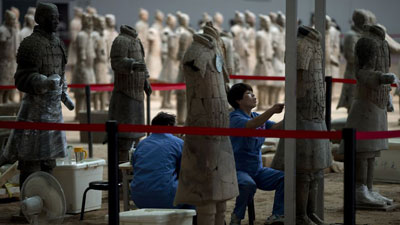 CHINA is expanding the ranks of the famed terra-cotta warrior army with new excavations expected to yield hundreds more of the ancient life-size figures. The museum overseeing the vast mausoleum of China’s first emperor says it began work March 30 on the tomb’s No. 2 pit, which is smaller in scale but believed to be richer in archaeological value than the already excavated No. 1 pit. Along with 1,400 warrior and horse statues, the pit is believed to contain 89 war chariots and 116 mounted soldiers, offering invaluable insights into the military culture of the Qin Dynasty (221-207 B.C.), the museum said in a statement on its website. “The No. 2 pit contains the true essence of the terra-cotta army,” Yuan Zhongyi, former curator of the museum, was quoted as saying. Chinese archaeologists have employed digital scanning for the excavation. Zhu Sihong, who is leading the excavation team, said advanced technology would play a greater role in the second excavation. The excavation team will use digital scanning to collect data on artifacts and build a database, which will facilitate future research and help preserve the site, Zhu said. Pit No. 2 features a mixed terra-cotta troop of chariots, cavalry and archers. The pit is also famed for housing several colorful warriors, including a rare specimen with a green face, indicating that the army was once painted various colors that faded throughout the ages. Discovered in 1974, the army is one of China’s biggest tourist draws, attracting hundreds of thousands of visitors each year. The army was built to guard the tomb of the first Qin emperor, Qinshihuang, who died in 210 after conquering much of what is now modern China. In all, the tomb’s three pits are thought to hold more than 8,000 figures of archers, infantry soldiers, mounted cavalry, horse-drawn chariots, officers, acrobats, musicians and more. The pit is adjacent to the emperor’s sprawling mausoleum that lies under a 76-meter mound and remains unexcavated while experts debate the pros and cons of doing so. Ancient accounts tell of a huge complex of chambers, including underground rivers filled with flowing mercury, along with the remains of artisans and imperial concubines sealed alive in the tomb with the dead emperor. The terra-cotta statues weigh about 180 kilograms each and range in height from 183-195 centimeters, depending on rank. Generals are the tallest. Originally brightly painted, they are intricately detailed with armor, top knots, weapons and boots. No two figures are alike, and it is believed that the sculptors modeled them after a real army. A ruthless figure of fear and awe in Chinese history, Qinshihuang built an extensive system of roads and canals along with an early incarnation of the Great Wall of China while unifying measurements and establishing a single written language, currency and legal statutes.(SD-Agencies) | 
